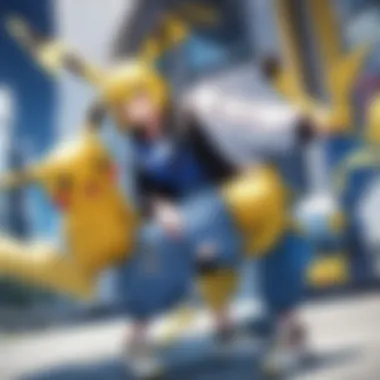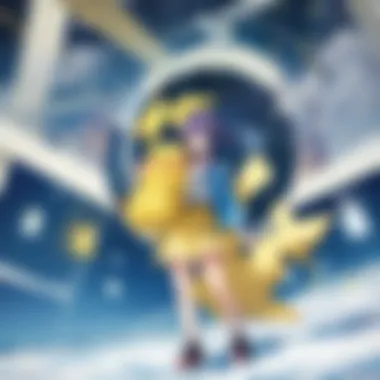Exploring the Multidimensional Nature of Pikachu in Pokémon Culture


Intro
Pikachu stands as a symbol of the Pokémon franchise, a character that has transitioned from a simple design to a complex figure infused with significant cultural meanings. This section aims to outline the significance of Pikachu within the broader discourse of Pokémon culture, its roots and evolution, and the ways it connects with diverse audiences around the globe.
Character Profiles
Overview of Main Characters
Pikachu, as the franchise's mascot, often interacts with a variety of characters, which enriches its role and allows for multifaceted storytelling. Ash Ketchum, Pikachu's loyal trainer, embodies the spirit of perseverance and friendship. Together, they navigate numerous challenges, highlighting themes of growth and resilience. Ash's unwavering dedication to becoming a Pokémon Master mirrors Pikachu's journey of evolving from a simple Pokémon into a powerful ally.
Additionally, Team Rocket, consisting of Jessie, James, and their talking Meowth, often pursue Pikachu for their selfish goals. This antagonistic relationship serves to underscore the significance of camaraderie and the struggle between good and evil. Characters like Misty and Brock also contribute to Pikachu's narrative, adding dimensions of friendship and support throughout their journey.
Supporting Characters
Supporting characters such as Professor Oak and Tracey Sketchit provide essential insights into Pokémon behavior and their ecosystems. These figures help frame Pikachu's existence within the larger context of a diverse world populated by various Pokémon species. Moreover, May and Dawn, who serve as Ash's companions in different series, highlight Pikachu's adaptability and its ability to foster connections beyond its immediate trainer.
Theme Exploration
Central Themes
Several themes resonate through Pikachu's representation in the Pokémon series. Identity and belonging play pivotal roles; Pikachu starts as an underdog, often underestimated due to its size but grows to become an iconic figure of strength and loyalty. The narrative underscores the value of perseverance and strength, emphasizing that one's worth is not always visible at first glance. Furthermore, friendship serves as a recurring motif, showcasing how relationships enhance personal development.
Cultural References
Pikachu’s cultural influence extends beyond the confines of the Pokémon apps and games. It has appeared on various merchandise, including toys and clothing, and is integral to notable events such as Pokémon conventions. Its image is frequently utilized in diverse media, signifying its reach and relevance in modern culture. Pikachu symbolizes unity and joy, often appearing at charity events and community gatherings, embodying the essence of connection across different social landscapes.
"Pikachu not only entertains but also connects different cultural threads, reinforcing the shared experience among fans globally."
Popular Series and Recommendations
Top Anime Series of the Year
If one seeks to explore more about Pikachu within the anime context, various series have offered engaging content. Notably, Pokémon Journeys broadens the narrative landscape, showcasing how Pikachu interacts with various cultures and new Pokémon. Likewise, Pokémon: The Series - Sun & Moon offers a refreshing perspective on traditional themes through a more relaxed, comedic format.
Hidden Gems in Manga
In the realm of manga, Pokémon Adventures provides a more in-depth storytelling experience that elevates Pikachu’s character alongside other key figures. This series delves into the strategic aspects of Pokémon battles and trainers’ developmental journeys.
For a comprehensive understanding of Pikachu's multidimensional influence in Pokémon culture, fans and scholars alike will find substantial insight through the exploration of both anime and manga. This analysis contributes to an appreciation of Pikachu, not just as a character, but as a cultural icon that continues to evolve in relevance and significance.
Prelude to Pikachu
The importance of Pikachu in this article cannot be overstated. As a central figure in the Pokémon franchise, Pikachu serves not only as a mascot but also embodies the evolution and impact of the franchise on global pop culture. By exploring Pikachu's journey and development, we gain insights into larger themes such as cultural representation, identity, and commercial dynamics. This introduction sets the stage for a more in-depth examination of Pikachu’s role across various media, illustrating its significance within the broader context of Pokémon culture.
Historical Context
Pikachu's origins trace back to the inception of the Pokémon franchise, which began in 1996 with the release of Pokémon Red and Green. Created by Satoshi Tajiri and Ken Sugimori, Pikachu was designed to resonate with a young audience. The character's design was inspired by various elements from nature, particularly rodents. Initially, Pikachu was not the sole focus, but its distinct features quickly led to its rise in popularity. This trajectory marks a pivotal moment in both gaming and anime history.
In the earliest days, Nintendo faced a competitive landscape dominated by other gaming franchises. However, Pikachu’s combination of cuteness and relatability allowed it to stand out. The character's introduction into the broader media landscape began with the Pokémon anime series, which debuted in 1997. The show solidified Pikachu's status as a household name, making it the face of a multi-billion-dollar franchise. Its role in the series, particularly as Ash's main companion, showcased its traits of loyalty and bravery, further endearing it to fans worldwide.
Understanding this historical context is essential. It reveals how Pikachu evolved from a mere game character to a symbol of friendship and adventure in the Pokémon world. It sets the framework for analyzing its character development and the multifaceted elements that contribute to its lasting appeal.
Initial Concept and Design
The initial concept of Pikachu was rooted in the creators’ vision of an approachable and charming character. Unlike many other Pokémon, which are often based on predatory or mythical creatures, Pikachu was specifically designed to be cute and non-threatening. This design choice played a crucial role in attracting a diverse audience, particularly children.


Pikachu's visual characteristics, such as its bright yellow color, round face, and large ears, make it instantly recognizable. The choice of color aimed to evoke feelings of happiness and warmth. Moreover, the character's design underwent minor alterations to ensure it remained consistent in various media formats.
Pikachu originally possessed the ability to generate electricity, a concept reflected in both its design and abilities within the games. This aspect of electricity not only makes Pikachu unique among Pokémon but also serves as a metaphor for energy and enthusiasm, qualities that resonate well with the youthful demographic.
In summary, understanding Pikachu's initial concept and design provides valuable insights into the marketing and narrative strategies of the Pokémon franchise. Pikachu was deliberately crafted to appeal to a global audience, demonstrating foresight and creativity that would lay the groundwork for its future success.
Character Development Across Media
The character development of Pikachu across various forms of media is critical to understanding its significance within Pokémon culture. This development showcases how Pikachu has evolved from a simple game character to a complex figure that resonates with diverse audiences. The journey of Pikachu highlights the interplay between character design, narrative depth, and audience engagement. This section delves into Pikachu's depiction in video games, anime series, and manga, revealing how each medium contributes uniquely to its character arc.
Pikachu in Video Games
In the realm of video games, Pikachu serves as the franchise's mascot and main representation. The early games, such as Pokémon Red and Blue, introduced Pikachu as one of the initial Pokémon trainers might encounter. Players quickly formed bonds with this character, creating a sense of attachment that persists in later installments. Visual and gameplay developments have kept Pikachu relevant; later games like Pokémon Sword and Shield offer expansive environments in which Pikachu can explore and grow.
Pikachu's moves and abilities have also evolved, impacting strategic gameplay. Over the years, Pikachu has adopted various forms, such as Gigantamax in recent titles. This exemplifies not only a visual transformation but also a shift in gameplay mechanics, providing players with new capabilities and ways to experience Pikachu's character.
Pikachu in Anime Series
The anime series represents a significant evolution of Pikachu's character. Introduced in the popular Pokémon animated series, Pikachu's personality became more pronounced. Originally portrayed as a simple creature, Pikachu was shown to have emotions, wit, and a strong bond with Ash Ketchum. This emotional depth played a crucial role in establishing Pikachu as not just a companion but also a pivotal character in the series.
The relationship dynamics in the series often reflect broader themes of friendship, loyalty, and perseverance. Pikachu's willingness to face formidable opponents emphasizes bravery, resonating with viewers, especially children. Notably, episodes highlighting Pikachu's struggles and triumphs become critical narratives, showcasing growth and resilience.
Pikachu in Manga
In manga adaptations, Pikachu exhibits differing characteristics, often serving as a comic relief but also reflecting moments of seriousness and depth. The Pokémon Adventures manga portrays Pikachu in a more adventurous light, offering a contrast to the more sentimental depiction in the anime. This allows Pikachu to appeal to a broader range of audiences, appealing to both younger readers and older fans.
The varied presentation of Pikachu in manga serves to expand its identity, allowing readers to view it through a different lens. Pikachu is shown as strategic, resourceful, and integral to the plot, further solidifying its importance within the Pokémon narrative.
Understanding Pikachu's character development across these media highlights how it transcends cultural boundaries, resonating with audiences worldwide.
In summary, Pikachu's character development is not merely about a cute mascot. It encapsulates the evolution of narrative strategies in video games, anime, and manga, reinforcing its status as an enduring symbol in Pokémon culture.
Symbolism and Representation
The concept of symbolism and representation in the context of Pikachu is vital to understanding its cultural impact. The character does not exist in a vacuum; instead, it encapsulates a multitude of emotions and ideals that resonate with fans across generations. Pikachu serves as a bridge between various stakeholders in the Pokémon franchise, from developers to fans. Understanding these layers can inform broader discussions on how media shapes cultural narratives.
Pikachu as a Cultural Icon
Pikachu is much more than a mere character in a game or show. The yellow creature’s lightning bolt-shaped tail and expressive face make it an instantly recognizable symbol in various cultures. It has transcended the realm of anime and gaming to become a global icon. Many people associate Pikachu with childhood nostalgia, which has a significant impact on its representation.
- Emotional Resonance: Pikachu evokes feelings of warmth and companionship. Its design and characteristics often symbolize friendship and loyalty, reflecting the relationships within the Pokémon universe.
- Versatility: The character has been adapted across different media formats, thus reinforcing its role as a cultural icon. From video games to merchandise like plush toys and clothing, Pikachu appears in various forms, appealing to a wide audience.
- Brand Ambassador: Not just for Pokémon, but Pikachu also represents Japan on an international stage. As a notable mascot in various events, the character symbolizes Japanese pop culture and tourism.
"Pikachu encapsulates not just fun but deeper meanings related to friendship, emotional connections, and cultural nostalgia."
Gender and Representation
Examining Pikachu through the lens of gender representation presents intriguing insights. While Pikachu’s gender is generally ambiguous, it reflects certain societal concepts.
- Gender Neutrality: Pikachu, often depicted in gender-neutral ways, allows fans from all demographics to relate. This broad representation can create a more inclusive environment in the fandom.
- Feminine Attributes: Some interpretations emphasize Pikachu’s cuteness, which aligns with societal views on femininity. This shows how cultural standards of beauty can be intertwined with representation.
- Role Model: As a powerful yet approachable character, Pikachu serves as a role model for younger audiences. It embodies traits such as resilience and determination, regardless of gender.
By delving deep into the symbolism and representation of Pikachu, we see its significance goes beyond entertainment. It provides insights into broader cultural narratives surrounding identity and community engagement.
Global Impact and Influence
The exploration of Pikachu's global impact and influence reveals the character's significance beyond just entertainment. This section focuses on how Pikachu not only symbolizes the Pokémon franchise but also serves as a bridge connecting various cultures and social dynamics. It examines the character's resonance in different contexts, from cultural representation to commercial strategies.
Pikachu in Popular Culture


Pikachu's presence in popular culture is profound. As a mascot for the Pokémon franchise, Pikachu appears in various forms of media, fashion, and art. The character has been incorporated into social media platforms, used in memes, and even featured in global marketing campaigns. Its distinct yellow color and simple design contribute to its recognizability.
The impact of Pikachu extends to global events. For instance, Pikachu often appears in cultural celebrations, such as parades and festivals, drawing crowds of different demographics. This phenomenon highlights the character's universal appeal, which transcends boundaries and fosters engagement among diverse groups of people.
Merchandising and Commercialization
The commercialization of Pikachu is a vital aspect of its global influence. From plush toys to clothing lines, Pikachu has become a lucrative product in the merchandise realm. Companies leverage Pikachu's image for marketing, promoting not just Pokémon products but various collaborations with brands like Uniqlo and McDonald’s.
The effectiveness of this merchandising strategy lies in Pikachu's recognition. The character's popularity often guarantees sales, making it a valuable asset for businesses. This commercial success has, in turn, contributed to the sustainable growth of the Pokémon franchise, making it one of the highest-grossing media franchises in history.
Pikachu as a Cultural Ambassador
Pikachu functions effectively as a cultural ambassador. It plays a role in familiarizing audiences with Japanese culture and values through its representation in anime and games. The character embodies traits such as friendship, teamwork, and perseverance, appealing to universal human emotions.
Moreover, Pikachu is often at the forefront of initiatives to promote cultural exchange. It serves as a figure for diplomatic events and international festivals, enhancing soft power for Japan. By representing the Pokémon franchise, Pikachu aids in bridging gaps between cultures, fostering understanding and appreciation amid diversity.
"Pikachu encapsulates a global phenomenon by representing not just a character but an entire culture, enhancing the intercultural dialogue around the world."
In summary, Pikachu's global impact and influence extend across various dimensions, capturing the hearts of many while enabling cultural exchange, driving commercial success, and establishing itself as an enduring icon.
Community Engagement
Community engagement plays a crucial role in understanding and celebrating Pikachu's presence within Pokémon culture. This topic highlights how fans connect, share, and influence each other through various forms of engagement. The significance of community interaction goes beyond mere entertainment; it fosters togetherness among fans and strengthens their shared experiences. Through social platforms and online forums, enthusiasts discuss their love for Pikachu while exchanging creations inspired by this beloved character. This collective enthusiasm helps Pikachu retain relevance in today’s fast-paced entertainment landscape.
Fan Art and Fan Culture
Fan art is a dynamic representation of fans' creativity and imagination. It reflects individual interpretations of Pikachu through different styles and mediums. This art not only serves as an expression of admiration but also builds a dialogue between fans. Many acclaimed artists within the Pokémon community have started their careers by sharing their Pikachu illustrations.
- Popularity of Fan Art: Platforms like DeviantArt and Instagram make it easier for artists to showcase their work and gain followers. Fans often create art for contests or simply to receive feedback from the community.
- Diverse Representations: The diversity is striking; from traditional anime styles to abstract interpretations, the multiplicity of Pikachu influences broaden the character's persona.
- Culmination of Styles: Different styles merge into a vibrant tapestry that showcases how Pikachu resonates with fans worldwide. It encourages various interpretations that reflect personal experiences.
Community events related to fan art, like online exhibitions or live drawing sessions, encourage engagement and solidify connections among fans. These gatherings give a nurturing space for artists and admirers alike. It allows them to explore creative boundaries and share new visions of Pikachu.
"The creativity unleashed by fans showcases how Pikachu transcends being just a character, establishing itself as a cultural phenomenon."
Events and Conventions
Events and conventions dedicated to Pokémon, where Pikachu is often a focal point, serve as central hubs for fan interaction. These gatherings enhance the excitement surrounding the franchise while allowing fans to meet in person and reinforce community bonds. Popular events such as Comic-Con and Pokémon World Championships often have a dedicated Pikachu presence through merchandise, panels, and cosplay events.
- Cosplay Participation: Many fans participate in cosplay, dressing as Pikachu or other Pokémon. Cosplay brings characters to life and highlights the importance of Pikachu in personal identities.
- Workshops and Panels: Events provide platforms for discussions about various aspects of Pikachu's evolution and cultural significance. Workshops encourage learning and creativity among attendees.
- Merchandising Opportunities: Merchandise related to Pikachu often flies off the shelves. It generates excitement, attracting fans to purchase items that celebrate their favorite character.
These conventions facilitate interactions, allowing fans to engage directly with creators and each other. This process fosters a sense of belonging and community, enriching the overall experience of participating in Pokémon culture. Ultimately, community engagement surrounding Pikachu reflects its enduring impact and the unity among fans.
Pokémon's Evolution and Pikachu's Role
The evolution of the Pokémon franchise is a multi-layered narrative that intertwines technological advances, gameplay mechanics, and intricate character development. Pikachu's role in this evolution is profound. As an iconic mascot, Pikachu embodies not only the spirit of the franchise but also its adaptability. This section highlights key elements concerning Pikachu's role in gameplay advancements and narrative innovations within the context of Pokémon's broader evolution.
Technological Advancements and Gameplay
From the inception of Pokémon Red and Blue, technological growth within gaming societies has mirrored the enhancement of gameplay experience. Early games were limited in terms of graphics and player interaction. Yet, Pikachu was strategically positioned as a focal point, engaging players with its charming character design and unique abilities. This simplistic yet effective gameplay was crucial for the early success of the franchise.
As technology improved, so did the complexity of gameplay. Subsequent generations introduced new mechanics such as Dynamax forms and mega evolutions, yet Pikachu remained relevant through these changes. Its adaptability showcases the developers’ focus on Pikachu as a central character, making it the face of new content while ensuring its abilities and design evolved alongside technological advancements.
These technical evolutions not only changed how players interacted with Pikachu but also how they understood and engaged with the narrative of the Pokémon universe. With each new release, Pikachu was integrated into features that echoed the cutting-edge innovations of the industry.
Narrative Arcs Involving Pikachu
Narratively, Pikachu has been integral in advancing storytelling across various mediums. In the Pokémon anime, Pikachu is Ash's companion and serves as a bridge for viewers to understand the world of Pokémon. This relationship deepens throughout the series. Pikachu's growth, both in terms of abilities and emotional depth, reflects the very essence of the journey theme prevalent in the franchise.


The character's arcs often touch on themes of friendship, loyalty, and growth. For example, episodes where Pikachu faces personal challenges resonate with audiences, creating an emotional connection that transcends mere gameplay mechanics. By focusing on Pikachu’s experiences, the narrative elevates engagement and creates rich storytelling that encourages players and viewers alike to invest in the emotional stakes.
Moreover, Pikachu has appeared in various narrative expansions, including films and spin-off series. Each story adds layers to its character, while still aligning the evolving nature of Pikachu with the overall franchise's narrative arc.
In summary, Pikachu not only serves as the mascot of the Pokémon franchise but acts as a linchpin in both gameplay advancements and narrative developments. This multidimensional role firmly cements Pikachu's importance in the ongoing evolution of Pokémon culture.
Pikachu in the Context of Anime and Gaming
Pikachu's place within the realms of anime and gaming is pivotal to understanding its role in contemporary culture. As a character, Pikachu encapsulates the spirit of Pokémon itself, serving as a bridge between diverse media and the audience. The synergy between Pikachu and the broader Pokémon franchise promotes engagement, nostalgia, and an understanding of character evolution over time.
Impact on Anime Trends
Pikachu significantly influenced anime trends from its inception in the late 1990s. Initially introduced in the anime series, Pikachu became a symbol of the Pokémon brand, paving the way for a new wave of animated shows characterized by monster companions and adventures. The design choices, such as Pikachu's cute features, contributed to a shift in audience expectations within the anime medium.
In anime, the character's interactions with Ash demonstrate the importance of relationships and teamwork. This thematic element resonated with viewers, shaping how characters in subsequent series were developed. Furthermore, Pikachu’s iconic status ushered in an era where character-driven narratives became increasingly popular. As a result, many creators began to incorporate similar companion characters, fostering a sense of connection between viewers and their favorite shows.
"Pikachu not only captured the hearts of fans but also influenced a generation of fellow anime characters, underlining the importance of strong emotional bonds in storytelling."
Moreover, Pikachu's presence in the anime series sparked the creation of merchandise, from toys to clothing, demonstrating its impact beyond the screen. The character’s voice, provided by Rica Matsumoto, became embedded in pop culture, generating immense recognition and setting a standard for anime character portrayal.
Pikachu's Place in Gaming History
Pikachu’s role in gaming history is equally important. It has transcended its original appearance in Pokémon Red and Blue, becoming a central figure in multiple game releases. This includes titles like Pokémon Snap and Pokémon Go, which expanded its reach to new audiences.
In the gaming realm, Pikachu serves more than just a protagonist; it represents the innovation that Pokémon brought to the industry. The introduction of mechanics like capturing creatures and building teams echoed throughout subsequent game development, influencing genres that focus on companions and creature collection.
Furthermore, Pikachu's character development has been integral to gameplay mechanics. In games, players connect with Pikachu uniquely, creating a bond that incentivizes continuing progress and sharing experiences in multiplayer settings. Its role in Super Smash Bros. has also solidified Pikachu as not just a symbol of the franchise but as a competitive character, showcasing its versatility and lasting appeal.
This relationship between Pikachu and video games contributes to its lasting legacy, as the character not only entertains but educates players about strategy and cooperation.
Psycho-Social Dynamics of Pikachu Fandom
Understanding the psycho-social dynamics of Pikachu fandom offers valuable insights into why this character holds a unique position in popular culture. Fandom often acts as a social bonding mechanism, uniting individuals with shared interests. In the case of Pikachu, the character’s appeal crosses age, gender, and cultural boundaries, creating a vast community of fans. This section will explore elements such as nostalgia and identity formation that contribute to the strength and resilience of this fandom.
Connection to Nostalgia
Nostalgia plays a crucial role in the appeal of Pikachu. For many fans, Pikachu represents a significant part of their childhood. The character first appeared in the late 1990s, coinciding with the rise of Pokémon in various forms of media, including video games, trading cards, and television shows. As adults look back on their formative years, Pikachu often emerges as a symbol of simpler times and joyous memories. This nostalgia can create a pause in the fast-paced nature of adult life.
Fans often share personal stories that intertwine their life experiences with Pikachu-related moments. This sharing further amplifies the nostalgia and bonds members of the fandom. Events such as Pokémon anniversaries or game launches can trigger feelings of nostalgia, encouraging fans to engage with the character and the franchise once again.
The phenomenon is not merely individual; it resonates with collective memory within the community. When fans reminisce about their first Pokémon game or vibrant Pokémon battles, they evoke a shared cultural experience. The nostalgia becomes a powerful tool for engagement, often seen in fan art, online discussions, and community events.
Identity Formation through Fandom
Pikachu fandom is not just about a love for the character; it is also about identity formation. Engaging in fandom allows individuals to forge and express their identities. Fans often adopt Pikachu as part of their self-image, using merchandise to signal their affiliation with the community. From cosplay at conventions to sharing Pikachu memes on social media, various forms of expression allow fans to connect with others who share the same passion.
Moreover, Pikachu transcends mere character appeal and embodies values embraced within the fandom. Traits like friendship, loyalty, and bravery associated with Pikachu resonate deeply. This connection can influence the self-concept of fans, forming a sense of belonging.
The identity-related dynamics can also manifest in how fans choose to present themselves within the fandom. Online, individuals often curate their profiles indicating their identification with Pikachu. Such acts create spaces that affirm their interests and solidify their social identity.
Ultimately, the psycho-social dynamics surrounding Pikachu extend beyond individual enjoyment. They highlight a complex interplay of nostalgia and identity, thereby enriching the fandom experience. Fans are not mere consumers of Pikachu-related content; they actively shape and contribute to a living cultural phenomenon.
End
The conclusion of this article serves as a critical reflection on Pikachu’s role within the vast universe of Pokémon culture. It encapsulates multiple layers of understanding about the character, addressing its significance not just as a beloved mascot but as a symbol rich in meaning and multiple interpretations.
Reflections on Pikachu's Legacy
Pikachu has established itself as more than a mere creature within the Pokémon franchise; it is a cultural phenomenon. Its legacy is characterized by an exceptional versatility that allows it to remain relevant across generations. The character is integral to the identity of Pokémon itself, embodying the spirit of adventure, friendship, and perseverance that define the franchise. Pikachu's design has also contributed to its lasting impact. Its appeal stretches from children to adults, resonating with diverse demographics. The character is linked to nostalgia, recalling memories of childhood for many players. This connection fosters an ongoing dedication from fans, creating a bond that transcends media forms, whether in games, anime, or merchandise.
Future Prospects
Looking into the future, Pikachu's presence is poised to evolve alongside advancements in technology and media. Emerging platforms and formats, such as virtual reality and augmented reality, present new opportunities for interaction with the character. These innovations can deepen the engagement of fans, offering immersive experiences that expand Pikachu's narrative potential. Furthermore, as Pokémon continues to expand its universe, Pikachu’s role may evolve, incorporating new storylines and abilities. This adaptability will secure its position in emerging trends within both gaming and animation industries. As the new generations of fans come into play, Pikachu will likely remain a central figure, constantly redefining its legacy.







